1993 PONTIAC BONNEVILLE oil
[x] Cancel search: oilPage 142 of 322
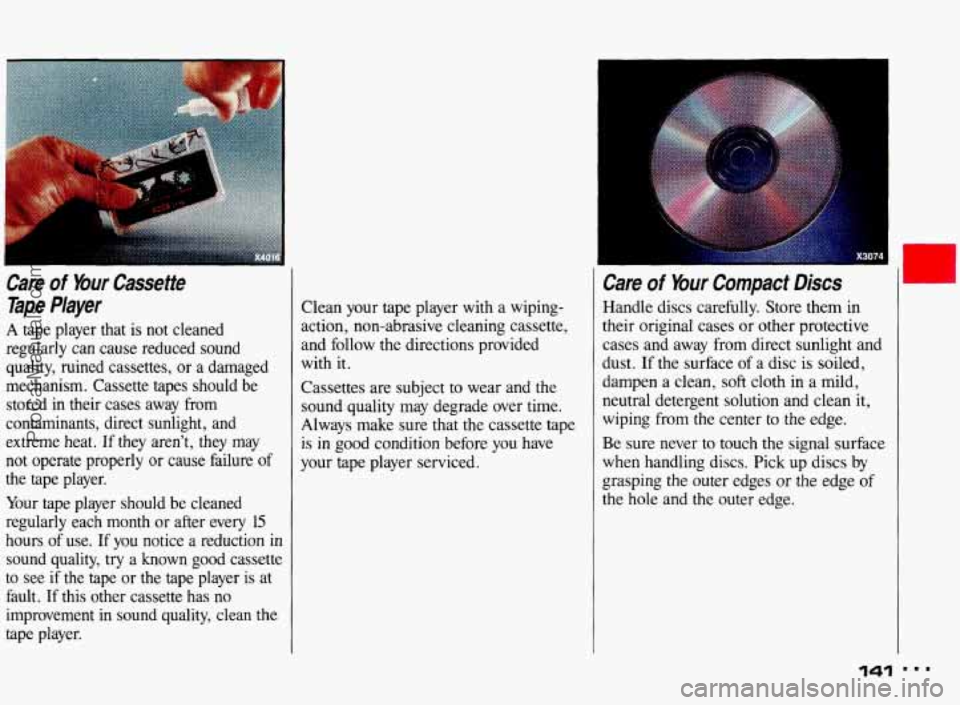
I
Care of Your Cassette
Tape Player
A tape player that is not cleaned
regularly can cause reduced sound
quality, ruined cassettes, or a damaged
mechanism. Cassette tapes should be
stored in their cases away from
contaminants, direct sunlight, and
extreme heat. If they aren’t, they may
not operate properly or cause failure of
the tape player.
Your tape player should be cleaned
regularly each month or after every
15
hours of use. If you notice a reduction in
sound quality,
try a known good cassette
to see
if the tape or the tape player is at
fault. If this other cassette has no
improvement in sound quality, clean
the
tape player. Clean
your tape player with a wiping-
action, non-abrasive cleaning cassette,
and follow the directions provided
with it.
Cassettes are subject to wear and the sound quality may degrade over time.
Always make sure that the cassette tape
is in good condition before you have
your tape player serviced.
Care of Your Compact Discs
Handle discs carefully. Store them in
their original cases or other protective
cases and away from direct sunlight and
dust.
If the surface of a disc is soiled,
dampen a clean,
soft cloth in a mild,
neutral detergent solution and clean it,
wiping from the center
to the edge.
Be sure never to touch the signal surface
when handling discs. Pick up discs by
grasping the outer edges or the
edge of
the hole and the outer edge.
141
U
I..
ProCarManuals.com
Page 175 of 322
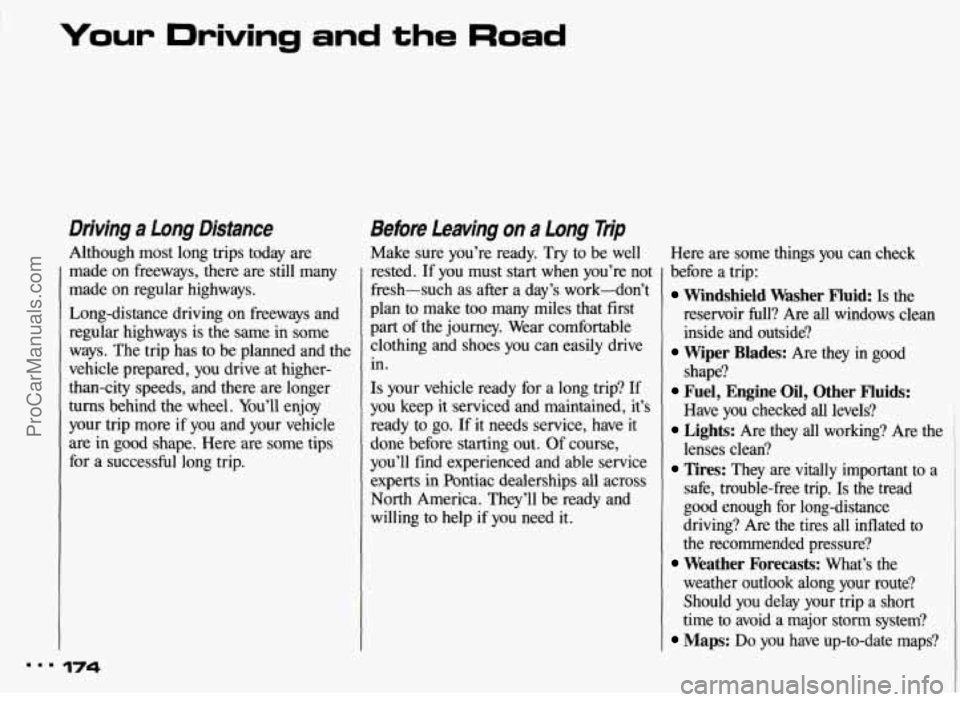
Your Driving and the Road
Driving a Long Distance
Although most long trips today are
made on freeways, there are still many
made on regular highways.
Long-distance driving on freeways and
regular highways
is the same in some
ways. The trip has to be planned and the
vehicle prepared, you drive
at higher-
than-city speeds, and there are longer
turns behind the wheel. You’ll enjoy
your trip more if
you and your vehicle
are in good shape. Here are some tips
for a successful long trip.
174
Before Leaving on a Long Trip
Make sure you’re ready. Try to be well Here are some things you can check
rested. If you must start when you’re not
fresh-such as after a day’s work-don’t
plan to make too many miles that first
part of the journey. Wear comfortable
clothing and shoes you can easily drive
in.
Is your vehicle ready for a long trip? If
you keep it serviced and maintained, it’s
ready to go. If it needs service, have it
done before starting out.
Of course,
you’ll find experienced and able service
experts in Pontiac dealerships all across
North America. They’ll be ready and
willing to help if you need it. before
a trip:
Windshield Washer Fluid: Is the
reservoir full? Are all windows clean
inside and outside?
shape?
Have you checked all levels?
lenses clean?
safe, trouble-free trip.
Is the tread
good enough for long-distance
driving? Are the tires all inflated to
the recommended pressure?
weather outlook along your route?
Should you delay your trip a short
time to avoid a major storm system?
Maps: Do you have up-to-date maps?
Wiper Blades: Are they in good
Fuel, Engine Oil, Other Fluids:
Lights: Are they all working? Are the
Tires: They are vitally important to a
Weather Forecasts: What’s the
ProCarManuals.com
Page 191 of 322

Your Driving and the Road
Maintenance When Tmiler Towing
Your vehicle will need service more
often when you’re pulling a trailer. See
the Maintenance Schedule for more
on
this. Things that are especially
important
in trailer operation are
automatic transaxle fluid (don’t overfill),
engine oil, belts, cooling system, and
brake adjustment. Each
of these is
covered
in this manual, and the Index
will help you find them quickly. If
you’re trailering, it’s a good idea to
review these sections before you
start
your trip.
Check periodically to see that all hitch
nuts and bolts are tight.
... 190
ProCarManuals.com
Page 205 of 322
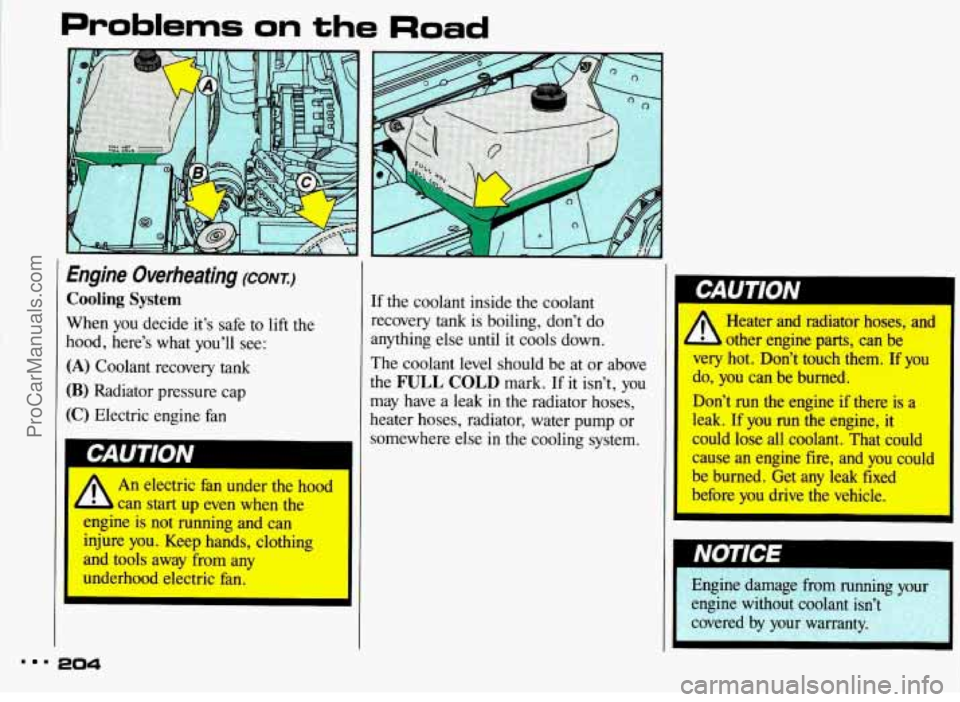
Problems on the Road
Engine Overheating (CONK)
Cooling System
When you decide it’s safe to
lift the
hood, here’s what you’ll see:
(A) Coolant recovery tank
(B) Radiator pressure cap
(C) Electric engine fan
An
electric fan under the hood
h can start up even when the
engine is not running and can
injure
you. Keep hands, clothing
and tools away from any
underhood electric fan.
If the coolant inside the coolant
recovery tank is boiling, don’t do
anything else
until it cools down.
The coolant level should be at or above
the
FULL COLD mark. If it isn’t, you
may have a leak
in the radiator hoses,
heater hoses, radiator, water pump or
somewhere else
in the cooling system.
I I 1 Heater and radiator hoses, anc
- other engine parts, can be
very hot. Don’t touch them.
If you
do, you can be burned.
Don’t run the engine if there is a
leak.
If you run the engine, it
could lose all coolant. That could
cause an engine fire, and you could
be burned. Get any leak fixed
before you drive the vehicle.
I
Engine damage from running your
engine without coolant isn’t
covered by your warranty.
.. . 204
ProCarManuals.com
Page 206 of 322
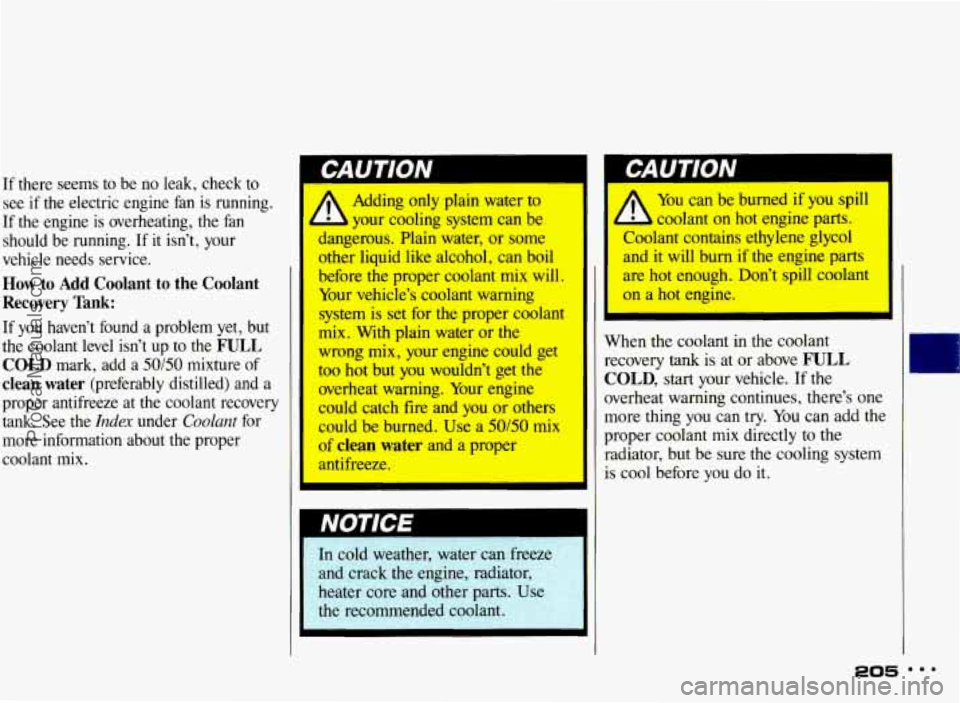
should be running. If it isn’t, your
vehicle needs service.
How
to Add Coolant to the Coolant
Recovery Tank:
If you haven’t found a problem yet, but
the coolant level isn’t up to the
FULL
COLD mark, add a 50/50 mixture of
clean water (preferably distilled) and a
proper antifreeze at the coolant recovery
tank. See the Index under Coolant for
more information about the proper
coolant mix.
I b-Au I IUN If there seems to be no leak, check to
see
if the electric engine fan is running. Adding only plain water to
If the engine is overheating, the fan L your cooling system can be
dangerous. Plain water, or some
other liquid like alcohol, can boil
before the proper coolant
mix will.
Your vehicle’s coolant
warning
,k L
You can be burned if you spill
coolant on
hot engine parts.
Coolant contains ethylene glycol
and it will burn if the engine parts
are
hot enough. Don’t spill coolant
on a hot engine.
system is set for the proper coolant
I
mix. With plain water or the
too hot but you wouldn’t get the
overheat warning. Your engine
could catch fm and you or others
be Use a mix
of clean water and a proper
antifreeze. When
the coolant in the coolant
COLD, start your vehicle. If the
overheat warning continues, there’s one
proper coolant mix directly
to the
more
thing you can try. You can add the
radiator, but be sure the cooling system
is cool before
you do it.
wrong
mix, Your
engine could get recovery tank is at or above FULL
I
In cold weather, water can freeze II
and crack the engine, radiator,
heater core and other
parts. Use
the recommended coolant.
I
r
205 ”
ProCarManuals.com
Page 216 of 322
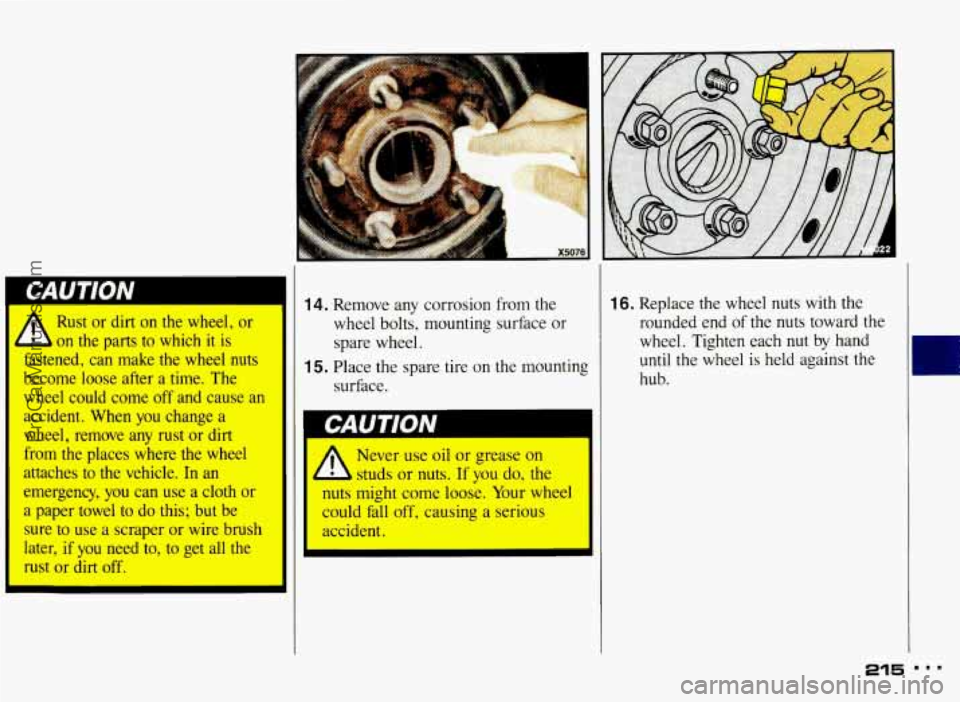
Rust or dirt on the wheel, or
b on the parts to which it is
fastened, can make the wheel nuts
become loose after a time. The
wheel could come
off and cause an
accident. When you change a
wheel, remove any rust or dirt
from the places where the wheel
attaches to the vehicle. In an
emergency, you can use a cloth or
a paper towel to do this; but be
sure to use a scraper or wire brush
later, if you need to, to get all the
rust or dirt off. II I
4. Remove any corrosion from the
wheel bolts, mounting surface
or
spare wheel.
5. Place the spare tire on the mounting
surface.
16. Replace the wheel nuts with the
rounded end of
the nuts toward the
wheel. Tighten each
nut by hand
until the wheel is held against the
hub.
A hTwer use oil or grease on
- aLdds or nuts. If you do, the
nuts might come loose. Your wheel
could fall off, causing a serious
accident.
215
ProCarManuals.com
Page 222 of 322
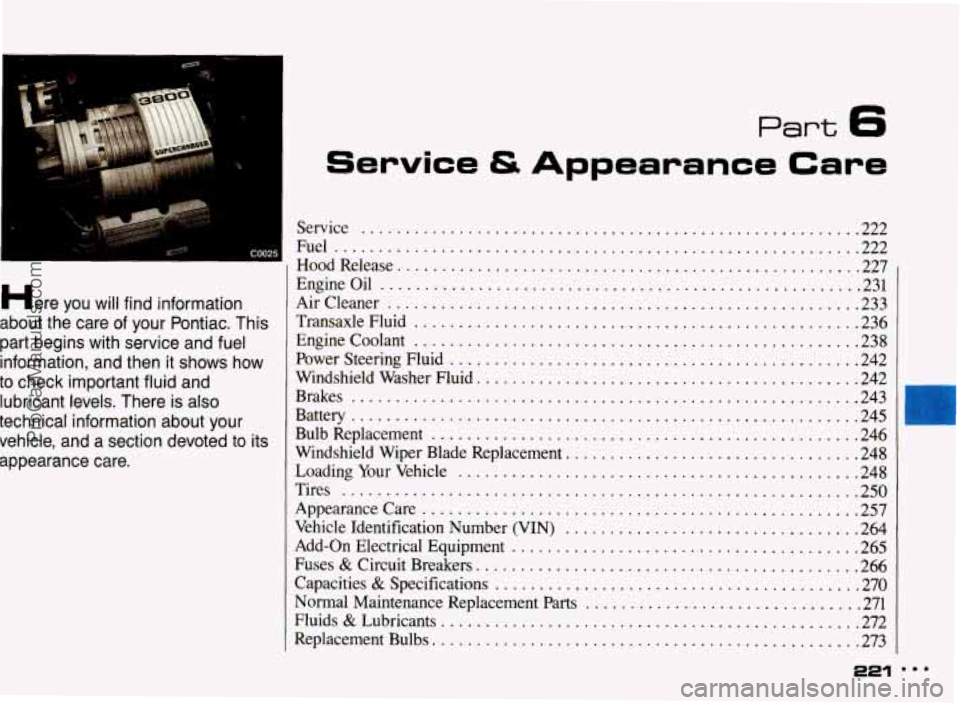
Part 6
I .
COO25
Here you will find information
about the care of your Pontiac
. This
part begins with service and fuel
information. and then it
shows how
to check important fluid and
lubricant levels
. There is also
technical information about your
vehicle. and
a section devoted to its
appearance care
.
Service G Appearance Care
Service ............................. .................. 222
Fuel
......................................................... 222
Engineoil
...................................................... 231
HoodRelease
.................................................... 227
Aircleaner
..................................................... 233
TransaxleFluid
.................................................. 236
Enginecoolant
.................................................. 238
Power Steering Fluid
.............................................. 242
Windshield Washer Fluid
........................................... 242
Bulb Replacement
.............................................. 246
Loading Your Vehicle
............................................. 248
Appearance Care
................................................. 257
Vehicle Identification Number (VIN)
................................. 264
Add-on Electrical Equipment
....................................... 265
Fuses
& Circuit Breakers ........................................... 266
Capacities
& Specifications ......................................... 270
Normal Maintenance Replacement Parts
............................... 271
Fluids
& Lubricants ............................................... 272
Replacement Bulbs
................................................ 273
Brakes
......................................................... 243
Battery
.......................................................... 245
Windshield Wiper Blade Replacement
...................... ....... 248
Tires
.......................................................... 250
221 ...
ProCarManuals.com
Page 226 of 322

Fuels in Foreign Countries
tf you plan on driving in another
country outside the
U.S. or Canada,
unleaded fuel may be hard to find.
Do not use leaded gasoline. If you use
even one tankful, your emission controls
won’t work well or at all. With
continuous use, spark plugs can get
fouled, the exhaust system can corrode,
and your engine oil can deteriorate
quickly. Your vehicle’s oxygen sensor
will be damaged. All of that means
costly repairs that wouldn’t be covered
by your warranty. To
check on fuel availability, ask an auto
club, or contact a major oil company
that does business in the country where
you’ll be driving.
You can also write us at the following
address for advice. Just tell us where
you’re going and give your Vehicle
Identification Number (VIN).
General Motors
of Canada Ltd.
International
Export Sales
P. 0. Box 828
Oshawa, Ontario L1H 7N1, Canada
Fuel Door Lock (omoN)
On SSE and SSEi models equipped with
the Theft-Deterrent System option,
the
fuel door is locked and unlocked
together with the power door locks.
Therefore, to unlock the fuel filler door,
you may use the outside door key lock,
the inside power door lock button, or
the Remote Keyless Entry key chain
transmitter.
To unlock the fuel door, just
unlock the driver’s door.
225
ProCarManuals.com